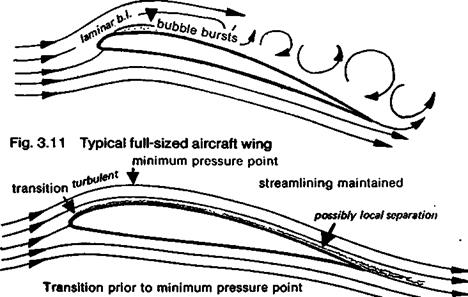SEPARATION BUBBLES
With favourable circumstance, if, for example, the deceleration of flow behind the ininimum pressure point is gradual, laminar separation may be followed by turbulent re – ichment (Fig. 3.6). The barrier of stagnant air disturbs the boundary layer in much the ie way as a ridge or hump on the wing and if the Re at this point is large eneugh, this іу bring about transition to turbulent flow. The increased thickness of the turbulent er brings it back to the wing surface, leaving the zone of stagnation as a separation >ble underneath. After this, the turbulent boundary layer continues against the pressure ienf and may reach the trailing edge without further separation. The greater average
momentum of the air particles in the lowest layers enables them to keep moving against the pressure forces tending to check them.
Within the separation bubble there is a local, detached circulation of flow with the layers of air nearest the skin flowing forwards. A very flattened vortex forms, extending spanwise. It has also been found that cross-vortices develop in the boundary layer behind the bubble, aligning themselves more or less chordwise.
Laminar separation bubbles are almost always present on model aircraft wings, often despite efforts to prevent their appearance by use of turbulators. They occur also on full – J sized sailplanes and other small, slow-flying aircraft, though with less serious effects. The | lower the Reynolds number, the larger the effect of the separation bubble on the total drag j of the wing. Sometimes the separation bubble may be 40% of the wing chord in extent, the j flow separates over the whole middle part of the upper surface, but re-attaches before the I trailing edge (Fig. 3.8). At high angles of attack the minimum pressure point on many | aerofoils moves forward and the bubble follows close behind, sometimes becoming, shorter. The turbulent boundary layer after the bubble may then not have sufficient energy to enable it to remain attached completely, and it may separate somewhere before the trailing edge. As the angle of attack increases further, the separation point moves almost to the leading edge, and eventually the ‘bubble’ bursts. This is how most model wings stall (Fig. 3.7 and 3.10). The direct result of the low Reynolds number is an early stall. In subsequent chapters these effects are examined in respect of their influence on the design of aerofoil sections for models.
On large wings at high speeds, laminar flow rarely persists far behind the leading edge because Re is high and small imperfections of the surface force early transition without a separation bubble. Full-sized powered aircraft are thus usually free from laminar separation problems (Fig. 3.11).
|
Fig. 3.10 Model wing at stall
|















